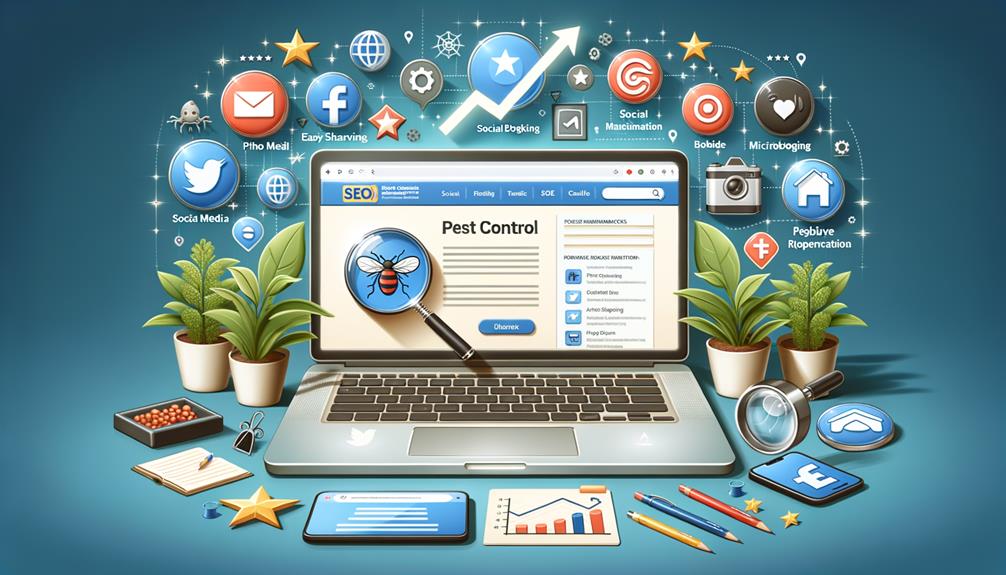Are you struggling to make your pest control company stand out in the digital world?
With the increasing competition and ever-evolving online landscape, it’s crucial to employ strategies that will catapult your online presence to new heights.
In this discussion, we will explore five essential strategies that will help you achieve just that.
From optimizing your website content to implementing effective SEO strategies, these techniques will not only attract more customers but also establish your brand as a trusted authority in the pest control industry.
So, buckle up and get ready to take your online presence to the next level.
Table of Contents
ToggleKey Takeaways
- Thorough keyword research is crucial for optimizing website content and improving search engine rankings.
- Creating high-quality and engaging content that addresses customer pain points is essential for attracting and retaining customers.
- Optimizing website loading speed through minimizing JavaScript and utilizing caching techniques is important to provide a seamless user experience.
- Implementing mobile responsiveness by designing a mobile-friendly website and optimizing page loading speed for mobile devices is necessary for reaching a wider audience.
Optimizing Website Content

To maximize the effectiveness of your pest control company’s website, it’s crucial that you optimize your website content. This involves two key elements: keyword research and content creation.
First and foremost, conducting thorough keyword research is essential. By identifying the specific keywords and phrases that potential customers are using to search for pest control services, you can strategically incorporate them into your website content. This will help improve your website’s visibility and search engine rankings.
When it comes to content creation, it’s important to produce high-quality and engaging content that’s relevant to your target audience. Your website content shouldn’t only provide valuable information about your pest control services but also address the pain points and concerns of your customers. By understanding their needs and challenges, you can create content that resonates with them and establishes your company as an authoritative source in the industry.
In addition to textual content, consider incorporating other types of content such as images, videos, and infographics to enhance the user experience and make your website more visually appealing. Remember to optimize these visual elements as well by adding relevant keywords in the alt tags and file names.
Improving Website Loading Speed
Improving your website’s loading speed is crucial for providing a seamless user experience and maximizing engagement with your pest control company’s online presence. When visitors land on your website, they expect fast-loading pages. If your website takes too long to load, they may become frustrated and leave, resulting in lost potential customers.
To prevent this, you should focus on minimizing JavaScript and utilizing caching techniques.
One effective way to improve your website’s loading speed is by minimizing JavaScript. JavaScript is a powerful scripting language that can enhance user experience, but it can also slow down your website if not optimized correctly. By minimizing the use of JavaScript and only including what’s necessary, you can significantly reduce load times and improve overall performance.
Another strategy to consider is utilizing caching techniques. Caching involves storing certain elements of your website, such as images and CSS files, in temporary storage on the user’s device. This allows for quicker retrieval of these elements when the user revisits your website. By implementing caching techniques, you can drastically reduce the time it takes for your website to load and provide a smoother user experience.
Enhancing Mobile Responsiveness

When it comes to optimizing your pest control company’s online presence, ensuring mobile responsiveness is essential for capturing the attention of potential customers on the go. With more and more people relying on their mobile devices to search for services, it’s crucial that your website is mobile friendly and provides a seamless user experience.
Here are five key strategies to enhance the mobile responsiveness of your pest control company’s website:
- Implement a mobile friendly design: Make sure your website is designed to be responsive and adapt to different screen sizes. This will ensure that your website looks great and functions properly on mobile devices.
- Prioritize user friendly navigation: Simplify your website’s navigation menu and make it easy for users to find the information they need. Avoid clutter and ensure that buttons and links are easily clickable on mobile screens.
- Optimize page loading speed: Mobile users expect fast loading times, so optimize your website to load quickly on mobile devices. Compress images and minimize the use of heavy scripts to improve loading speed.
- Use clear and concise content: Mobile screens are smaller, so make sure your content is concise and easy to read. Use bullet points, headings, and short paragraphs to improve readability.
- Test across different devices: Test your website on various mobile devices to ensure it looks and functions well on all of them. This will help you identify and fix any compatibility issues.
Implementing Effective SEO Strategies
Implementing effective SEO strategies is crucial for maximizing your pest control company’s online visibility and attracting organic traffic to your website. To ensure that your website ranks high in search engine results, you need to conduct thorough keyword research.
Identify the keywords and phrases that potential customers are using to search for pest control services in your area. By strategically incorporating these keywords into your website’s content, meta tags, and headers, you can increase your chances of appearing in relevant search results.
In addition to keyword research, link building is another essential SEO strategy. Building high-quality backlinks from reputable websites can significantly improve your website’s search engine rankings. Reach out to industry influencers, local directories, and relevant blogs to request backlinks to your website.
You can also create informative and engaging content that other websites would want to link to. By building a strong network of backlinks, search engines will view your website as a trusted and authoritative source, leading to higher organic traffic.
Utilizing Local Search Optimization

To boost your pest control company’s online visibility and attract local customers, harness the power of local search optimization. By utilizing this strategy, you can ensure that your business appears prominently in local search results, making it easier for potential customers in your area to find you.
Here are five key tactics to implement:
- Optimize your website for local keywords: Incorporate geo-targeted keywords throughout your website’s content, meta tags, and headers to improve your chances of ranking higher in local search results.
- Claim and optimize your local directory listings: Ensure that your business is listed accurately on popular local directories such as Google My Business, Yelp, and Yellow Pages. Fill out all the relevant information and add photos to enhance your listing’s visibility.
- Encourage customer reviews: Positive reviews not only build trust with potential customers but also improve your local search rankings. Encourage satisfied customers to leave reviews on platforms like Google or Yelp.
- Create location-specific landing pages: If you serve multiple cities or regions, create individual landing pages for each location. Optimize these pages with relevant keywords and provide specific information about your services in that area.
- Leverage local backlinks: Seek opportunities to build relationships with local businesses, bloggers, and organizations. By obtaining backlinks from reputable local sources, you can improve your website’s authority and visibility in local search results.





